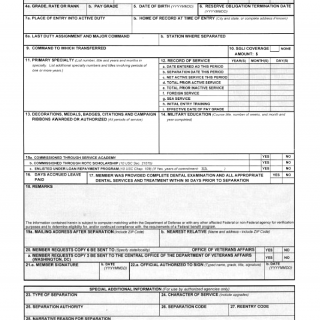DD Form 214. Certificate of Release or Discharge from Active Duty
DD Form 214 is a Certificate of Release or Discharge from Active Duty, which is a document issued by the United States Department of Defense to service members who are separating from the military. The DD Form 214 provides important information about a service member's military service, including their dates of service, character of service, and discharge status.
The DD Form 214 is an important document that service members should keep in a safe place, as it is often required for a variety of purposes, such as applying for veterans benefits, obtaining employment, or proving military service for other purposes.
The information contained on the DD Form 214 includes the following:
- Personal information, such as the service member's name, rank, and service number
- Dates of service, including the service member's entry and discharge dates
- Character of service, which describes the service member's overall military performance and conduct
- Awards and decorations received during the service member's military career
- Education and training received during military service
- Military occupational specialty (MOS) or job title held by the service member
- Separation information, including the reason for separation and the type of discharge received
If a service member needs a copy of their DD Form 214, they can request one from the National Archives and Records Administration (NARA).
How to Request DD Form 214
To request a copy of your DD Form 214, you can follow these steps:
- Determine eligibility: In general, veterans, their next of kin, and authorized representatives can request a copy of the DD Form 214. The National Archives and Records Administration (NARA) has specific eligibility requirements that you can review on their website.
- Complete the SF-180 form: The SF-180 form is the Request Pertaining to Military Records. You can complete this form online or print it out and fill it in manually. The form requires information about your military service, such as your name, service number, and dates of service.
- Submit the SF-180 form: Once you have completed the SF-180 form, you can submit it to the National Personnel Records Center (NPRC) by mail or fax. The address and fax number are provided on the SF-180 form. This can also be done online through the eVetRecs System. https://vetrecs.archives.gov/VeteranRequest/home.html
- Wait for processing: The NPRC will process your request and mail a copy of your DD Form 214 to you. Processing times may vary depending on the volume of requests and the complexity of your case.
- Request expedited service: If you need your DD Form 214 more quickly, you can request expedited service by providing a reason for the urgency and supporting documentation. There may be additional fees for expedited service.
It is important to note that the process for requesting a copy of your DD Form 214 may vary depending on your specific circumstances.
DD Form 214 Benefits
The DD Form 214 is a very important document for veterans, as it provides proof of military service and discharge status. Here are some of the reasons why a DD Form 214 is needed:
- Veterans benefits: The DD Form 214 is often required to apply for veterans benefits, such as healthcare, disability compensation, education benefits, and home loans.
- Employment: Employers may ask for a copy of the DD Form 214 to verify a veteran's military service and discharge status. Some employers may also give preference to veterans in the hiring process.
- Burial benefits: The DD Form 214 is required to apply for burial benefits in a national cemetery or for a headstone or marker.
- Membership in veterans organizations: Some veterans organizations require a copy of the DD Form 214 as proof of military service.
- Personal records: The DD Form 214 serves as an important personal record of military service, including awards and decorations received, training and education completed, and job duties performed.
Overall, the DD Form 214 is an important document that veterans should keep in a safe place, as it is often required for a variety of purposes throughout their lives.

